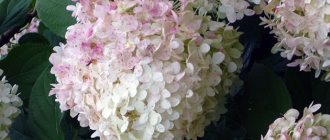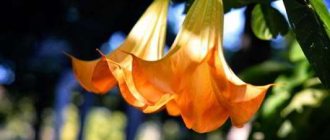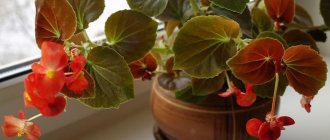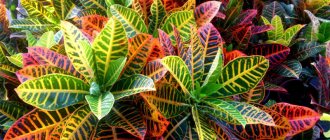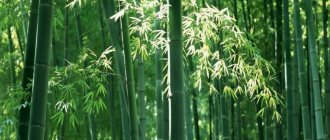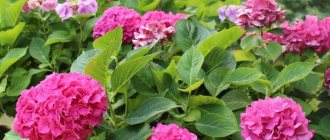Home » Landscape design » Lianas, Bushes and Trees
Irina Borodina 05/27/2020
20634 Views
Due to its unusual appearance and dissimilarity from other flowers, hydrangea is considered a plant crop of the East. There is some truth in this: it really comes from the Far East and grows in Japan and China, and is found in the Kuril Islands and Sakhalin.
Its lush bushes are not uncommon in North America. Caring for hydrangea cannot be called simple, but the work of the gardener pays off with the airy caps of inflorescences that appear in the garden in July and delight with abundant flowering until October.
Description of the plant
Hydrangea belongs to the hydrangea family. French breeders were the first to start breeding it at the beginning of the 20th century, and in the 60s there were already more than 100 varieties representing 80 species.
Breeders from the largest suppliers in France and Germany are still breeding new varieties today in order to obtain unusual flower colors, increase their fullness and create amazing leaf shapes.
The shrub has become so popular all over the world that new varieties of hydrangeas have appeared that can be grown at home on windowsills.
The main characteristics of hydrangea are:
- fruit-bearing crop. The fruit is a capsule with chambers from 2 to 5, in which small seeds ripen;
- in gardens it grows up to 3 m in the form of a lush tree. In nature, it is found in the form of vines, climbing through neighboring trees up to a height of 30 m. Individual plants have the form of a lush shrub;
- has two groups - deciduous and evergreen;
- the leaves opposite each other are large with veins. The shape is oval, with a pointed tip and serrated edges;
- inflorescences in the form of a cone, cap, shield, ball with many buds. Plants with paniculate inflorescences are identified as a separate species;
- The color palette is striking in its diversity. Lilac, white, pink, red, crimson, burgundy colors and their variations are considered especially popular;
- There are two types of flowers - fertile (fruit-bearing) and sterile, which are located at the edges of the inflorescence. There are some species that have only fruit-bearing flowers;
- flowers change color as they age;
- Flowering period - from late spring to frost. An amazing feature of the flower is its dependence on the soil. If the acidity is neutral, then the flowers are beige or cream; if the soil is acidic, then the petals acquire blue shades; in alkaline conditions, pink or lilac shades. Therefore, in order to get brighter shades of blue, varieties with blue flowers should be grown on acidic soils, and varieties with pink flowers on alkaline soils;
- combines effectively with other trees, shrubs and flowers.
Diseases and pests
Proper care is the key to healthy hydrangea. High humidity and low temperatures can cause fungal infections that affect leaves and flowers. Such diseases include powdery mildew, septoria, rust, downy mildew, gray and white rot. For preventive purposes, it is recommended to treat hydrangea tree with Bordeaux mixture. A diseased plant is treated with specialized fungicidal agents.
Sometimes hydrangea is affected by insect pests: aphids, slugs, spider mites, nematodes. With a small lesion, you can try to destroy the parasites using folk remedies. To do this, prepare a garlic or tobacco solution (100 g per 5 liters of water), leave it for 2 days. Before spraying, add a small amount of soap to the solution so that the infusion adheres well to the leaves.
In case of significant damage, you will have to use the appropriate insecticides - “Aktellik”, “Aktara”, “Fitoverm” and others.
Advantages of hydrangea
The best garden decoration, according to gardeners, has the following advantages:
- a wide variety of species and varieties, which allows the most picky gardener to choose a shrub;
- you can create a hedge from picturesque shrubs;
- rarely gets sick and is not afraid of pests;
- long and lush flowering;
- Arrangements made from dried flowers look beautiful;
- A sweet drink made from hydrangea (amacha) has magical properties. Therefore, Buddhists classify it as ritual;
- leaves and roots have medicinal properties.
There is one drawback - some types of this beautiful bush are not frost-resistant and cannot delight Russians with their flowering.
Medicinal properties
It is curious that humanity knew about the healing qualities of the plant several centuries ago. Hydrangea root was used in the treatment of various diseases of the urinary system, removing harmful substances from the body and relieving edema.
An extract from the root of the plant, due to its diuretic properties, has an antimicrobial effect, relieves spasms, and can be used as a pain reliever for the urinary organs. Improves the functional capacity of the kidneys and greatly facilitates the well-being of patients with prostate diseases.
Hydrangea variety
Today, garden markets offer various types and varieties of hydrangea, the new and well-known varieties of which are:
- tree-like Grandiflora has a spherical crown. It attracts the attention of gardeners because during the flowering period (July - September) the color of the flowers changes several times. The bushes love sunny places and do not tolerate drought;
- Paniculate, honey-bearing and frost-resistant Kyushu, which has a fan-shaped crown up to 3 m. Height reaches 3 m;
- The large-leaved, winter-hardy Romance Blue grows to a height of 1.5 m. Double flowers, collected in a spherical inflorescence, are formed on last year's branches. Loves the sun;
- Winter-hardy, not requiring shelter, Endles Summer, nicknamed “endless summer” because it blooms on last year’s and new shoots. On acidic soils, the color changes from blue to pink.
The photo of hydrangea shows the variety of its species and varieties.
Oakleaf
The leaves of this type of hydrangea are very similar in appearance to oak leaves with a very impressive reddish color. The inflorescences are most often white. These are rather low shrubs, barely reaching one meter in height. What types of hydrangeas are there? The most popular large-leaved varieties are as follows:
- The “amethyst” variety grows up to one and a half meters tall. The inflorescences are painted in a delicate coral shade. Their appearance resembles spears.
- "Princess" is the most profusely flowering variety of all oakleaf hydrangeas. The petals are painted white.
- A fairly tall variety of “snow-white domes”, the bushes sometimes reach one and a half to two meters. The buds, collected in fairly large inflorescences, are also white. The photo of the “snow-white dome” is presented above.
- The “Harmony” variety often has to be tied up due to its abundant flowering. Its leaves turn purple in autumn. It looks pretty impressive.
- The leaves of Burgundy are colored in the same way. The edges of the leaf blade are rounded, and their size is slightly longer than that of other varieties of oakleaf hydrangea.
- Perhaps the most attractive variety is the “little honey cake”. It gets its name from its yellow leaves, which turn burgundy in autumn.
Caring for oakleaf hydrangea is practically no different from other types of plants. She loves moisture and sun, good fertilizing and loosening of the soil. In winter, the temperature should not drop below 23 degrees. Otherwise, the hydrangea will have to be covered to prevent it from freezing.
These types of hydrangeas are pruned only in spring. Moreover, as a rule, they are limited to only removing dried inflorescences. It practically does not need regular pruning, unlike other types of plants. Among the disadvantages of tree hydrangea, they note its low winter hardiness and tendency to fungal diseases. These plants are propagated by cuttings or layering.
Soil requirements
Of great importance for Hydrangea is the land, which at the landing site should be:
- fertile,
- loose,
- air and water permeable,
- with neutral acidity or slightly acidic. Heavy clay acidic soil should be neutralized with dolomite flour (2 kg of flour per 5 sq. m of area). This procedure is good to carry out in autumn days or three weeks before spring planting;
- not alkaline soil. To protect the plant from such areas, it is necessary to avoid areas near the washbasin or the place where water used in the household is drained.
Reproduction methods
Hydrangea can be propagated in three ways.
Green cuttings
Cuttings are cut in early June with 2-3 pairs of leaves. Half of the leaf blade is cut off. Cut shoots are placed in a root growth stimulator for 5 minutes. The cuttings are planted in a greenhouse or in a bed with light nutritious soil. They shade. The lower paired buds are deepened into the soil to the middle of the internode.
After 20-30 days, the cuttings will take root. Throughout this period, it is necessary to maintain high humidity by covering the cutting with a cut plastic bottle.
By layering
In spring, the shoot is carefully bent to the soil, placed in a shallow groove, sprinkled with a 2 cm thick layer of soil substrate, and pinned. There is no need to sprinkle the tip of the shoot; bend it slightly upward.
The soil must be kept moist throughout the season. In summer and autumn the soil needs to be topped up. Next spring, the rooted shoot is separated from the adult bush with pruning shears. It is planted in fertile soil in a shaded area for growing.
Tree hydrangea grown from layering or cuttings can be planted in a permanent place after a year or two. The young shrub will bloom in the 4th year.
Dividing the bush
Hydrangea is dug up and divided using pruning shears or a sharp shovel. New parts of the plant are planted in a hole that is prepared in advance. Then the branches are cut off. The divided hydrangea takes root well.
Site requirements
When growing charming bushes, you should know what properties the site should have. Otherwise they may die.
Important features of the site include:
- the place should be darkened so that only in hot hours (from 12 to 15) the hydrangea does not receive direct rays of the sun, otherwise the flower will not delight with lush flowering;
- reliable shelter from drafts and cold winds. It is better to plant this delicate creature on the south side of the house. Bushes should be protected from cold winds by a fence or other trees and shrubs, without shading the sun;
- On the site, groundwater should be located at least one and a half meters from the ground. Bushes should not be in water. The beds for planting should be made high from 0.50 m and above;
- Black currants, white acacia, herbs, and garlic should not be adjacent to the flower.
Luxurious bouquets of “Japanese roses”
Hydrangeas are versatile flowers that do not have a strong scent and look beautiful in any composition. Bouquets of them are usually given as a sign of expressing sincere and heartfelt feelings. The Japanese believe that these flowers bring joy and harmony and can protect a young family from grief and troubles. Therefore, hydrangea is especially relevant in wedding decor and bridal bouquets.
In the photo: a basket of peonies and hydrangeas
Peonies and hydrangeas look most charming in one lush composition with the same color scheme. Original combinations are obtained with tulips, orchids and lilies. A bouquet of roses in combination with a snow-white beauty from Japan looks truly luxurious.
Pink hydrangeas harmoniously coexist with hyacinths and roses. The bouquets turn out to be truly romantic, capable of expressing all the sincerity of the donor’s tender feelings. Interesting lush compositions with a unique aroma are obtained when combined with lavender and hosta leaves.
These flowers are often used to make a wedding bouquet for the bride. The most popular hydrangeas for such special occasions are blue, pink and pastel shades, creating the image of a romantic dreamer.
Delicate colors give the lush bouquet the illusion of airy lightness. But snow-white compositions, which can be supplemented with peonies or lilies of a similar color, are still considered classics. The bride will be especially beautiful with them.
Decisive and courageous ladies can choose a bouquet of violet-lilac tones, diluting it with flowers in beige tones. Such compositions would be most appropriate for an autumn wedding.
Growing hydrangea
When growing plants, you should strictly follow the rules of planting and caring for hydrangeas in the open ground. Then the extraordinary beauty will delight you with amazing blooms for a long time.
Landing rules
Transplantation and planting should be carried out only in the spring at the end of May. Beginners often make a serious mistake, believing that these procedures can be performed from the end of August to September. Only in the southern regions of Russia is this permissible.
Hydrangea is difficult to establish, so it must be given enough time to get stronger before frost.
Normal planting in the ground determines a given sequence of stages.
- Prepare holes 40 by 40 cm.
- Place 10 cm of drainage layer (brick or crushed stone) in the hole.
- Fill each hole with the prepared mixture. It is recommended to make a mixture of the top fertile layer, rotted manure, leaf soil and river sand in equal proportions.
- Add a quarter of a bucket of wood ash into the holes with the addition of 2 tablespoons of superphosphate and 1.5 tablespoons of potassium sulfate. Add a glass of dolomite flour to holes in acidic soil.
- Plant the seedlings so that the root neck is at ground level.
- Water well (3-6 liters) under each bush and mulch (peat chips or sawdust). This will help retain moisture longer and get rid of weeds.
Shrub care
Features of flower care are as follows:
- It is important to know how to water correctly. During hot periods, water 2 times a week. For each bush, use 30-50 liters of settled warm water. You cannot water with cold water! If the area is mulched with peat, you can water it once a week;
- loosen to a depth of 5 cm several times during the growing season;
- cut off the stems on which the inflorescences have faded;
- if you want to change the color of a flower, you can acidify the soil or, on the contrary, make it alkaline or neutral;
- carry out timely pruning of 3-4 year old bushes;
- Do not add a lot of organic matter to the soil so that the plant blooms luxuriantly. Feed the plant at least 2 times a year (at the beginning and after flowering);
- prepare well for winter - pick off faded flowers, hill up high, cover.
Reproduction
There are three ways to propagate hydrangea.
- Seeds. Breeders use hydrangea seeds. The method is easy, but takes a lot of time.
- Saplings. Planting of seedlings in the ground is carried out in early spring.
- Cuttings. There should be 3-4 buds on the cut stem. Planting hydrangeas in open ground is possible only after the cuttings have rooted.
One of the myths about the amazing flower says that on Buddha’s birthday, magnificent flowers began to fall from the sky and the sweet drink “amacha” began to flow. At that moment, they saw hydrangea on Earth - “Ajisai”, which Buddhists called the flower of Buddha.
Paniculata
It grows in the form of tall trees and extensive shrubs up to 2-5 m high. It is a winter-hardy variety and is often used to decorate gardens. With timely pruning, the bushes can be given any desired shape, which has made these hydrangeas true leaders among their “relatives” in landscape design.
There are dozens of varieties and many hybrids have been bred that allow you to admire the most amazing shades. Here are the most popular among them.
Bobo
This is an early hybrid variety obtained by Belgian breeders. The height of the bushes reaches 70 cm. Bobo blooms in May with pink flowers that look beautiful against the background of numerous emerald leaves.
Photo of Hydrangea plant
Wintering
Before covering, it is necessary to tear off all the flowers on the garden hydrangea, as well as remove weak or broken shoots.
Some varieties of hydrangea are recommended to be pruned or tied. This will help preserve the branches during snowfall and rain.
The root ring is hilled up and covered tightly with mulch. Since even in frost-resistant species, the root system is close to the surface and can freeze.
Young and heat-loving plants are bent to the ground and covered with earth. Additionally covered with roofing felt or covering material.
Experienced gardeners recommend covering plants with a metal frame in the shape of a cylinder. The empty space around the bush is filled with dry leaves or other insulation. The top of the structure is covered with covering material.
Pots with home flowers must be brought indoors. If you leave them outside, the root system will freeze and the hydrangea will die.




